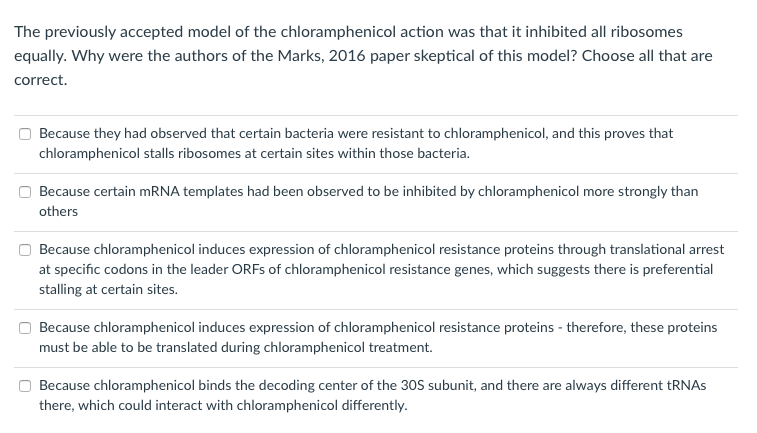The previously accepted model of the chloramphenicol action was that it inhibited all ribosomes equally. Why were the authors of the Marks, 2016 paper skeptical of this model? Choose all that are correct. Because they had observed that certain bacteria were resistant to chloramphenicol, and this proves that chloramphenicol stalls ribosomes at certain sites within those bacteria. Because certain MRNA templates had been observed to be inhibited by chloramphenicol more strongly than others Because chloramphenicol induces expression of chloramphenicol resistance proteins through translational arrest at specific codons in the leader ORFS of chloramphenicol resistance genes, which suggests there is preferential stalling at certain sites. Because chloramphenicol induces expression of chloramphenicol resistance proteins - therefore, these proteins must be able to be translated during chloramphenicol treatment. Because chloramphenicol binds the decoding center of the 30S subunit, and there are always different tRNAS there, which could interact with chloramphenicol differently.
The previously accepted model of the chloramphenicol action was that it inhibited all ribosomes equally. Why were the authors of the Marks, 2016 paper skeptical of this model? Choose all that are correct. Because they had observed that certain bacteria were resistant to chloramphenicol, and this proves that chloramphenicol stalls ribosomes at certain sites within those bacteria. Because certain MRNA templates had been observed to be inhibited by chloramphenicol more strongly than others Because chloramphenicol induces expression of chloramphenicol resistance proteins through translational arrest at specific codons in the leader ORFS of chloramphenicol resistance genes, which suggests there is preferential stalling at certain sites. Because chloramphenicol induces expression of chloramphenicol resistance proteins - therefore, these proteins must be able to be translated during chloramphenicol treatment. Because chloramphenicol binds the decoding center of the 30S subunit, and there are always different tRNAS there, which could interact with chloramphenicol differently.
Biology (MindTap Course List)
11th Edition
ISBN:9781337392938
Author:Eldra Solomon, Charles Martin, Diana W. Martin, Linda R. Berg
Publisher:Eldra Solomon, Charles Martin, Diana W. Martin, Linda R. Berg
Chapter14: Gene Regulation
Section: Chapter Questions
Problem 13TYU: INTERPRET DATA Develop a simple hypothesis that would explain the behavior of each of the following...
Related questions
Question

Transcribed Image Text:The previously accepted model of the chloramphenicol action was that it inhibited all ribosomes
equally. Why were the authors of the Marks, 2016 paper skeptical of this model? Choose all that are
correct.
Because they had observed that certain bacteria were resistant to chloramphenicol, and this proves that
chloramphenicol stalls ribosomes at certain sites within those bacteria.
Because certain MRNA templates had been observed to be inhibited by chloramphenicol more strongly than
others
Because chloramphenicol induces expression of chloramphenicol resistance proteins through translational arrest
at specific codons in the leader ORFS of chloramphenicol resistance genes, which suggests there is preferential
stalling at certain sites.
Because chloramphenicol induces expression of chloramphenicol resistance proteins - therefore, these proteins
must be able to be translated during chloramphenicol treatment.
Because chloramphenicol binds the decoding center of the 30S subunit, and there are always different tRNAS
there, which could interact with chloramphenicol differently.
Expert Solution
This question has been solved!
Explore an expertly crafted, step-by-step solution for a thorough understanding of key concepts.
This is a popular solution!
Trending now
This is a popular solution!
Step by step
Solved in 2 steps

Recommended textbooks for you

Biology (MindTap Course List)
Biology
ISBN:
9781337392938
Author:
Eldra Solomon, Charles Martin, Diana W. Martin, Linda R. Berg
Publisher:
Cengage Learning

Biochemistry
Biochemistry
ISBN:
9781305577206
Author:
Reginald H. Garrett, Charles M. Grisham
Publisher:
Cengage Learning

Biology (MindTap Course List)
Biology
ISBN:
9781337392938
Author:
Eldra Solomon, Charles Martin, Diana W. Martin, Linda R. Berg
Publisher:
Cengage Learning

Biochemistry
Biochemistry
ISBN:
9781305577206
Author:
Reginald H. Garrett, Charles M. Grisham
Publisher:
Cengage Learning